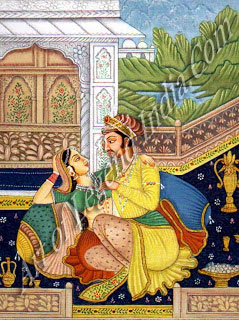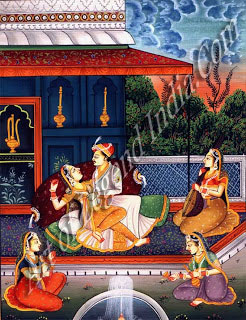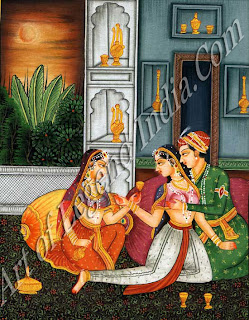 Radha
makes her debut as Krishna's chief consort in the Gitagovinda. Previously she
was known only from sporadic literary and epigraphical references, beginning in
the seventh century. Radha is absent from the major early texts in which the
life of Krishna is related: the Bhagavatapurana, Harivamsa,and
Vishnupurana. In these earlier texts, Krishna dallies with an anonymous group
of cowherdesses (gopis) rather than a favorite lover. As a result of the
exclusive emphasis accorded Radha in the Gitagovinda, her fame and popularity
grew so powerful that one sect, the Radhavallabhis founded in the sixteenth
century at Brindavan near Mathura, regarded her as supreme over Krishna and to
be the cosmic source of his divine energy.
Radha
makes her debut as Krishna's chief consort in the Gitagovinda. Previously she
was known only from sporadic literary and epigraphical references, beginning in
the seventh century. Radha is absent from the major early texts in which the
life of Krishna is related: the Bhagavatapurana, Harivamsa,and
Vishnupurana. In these earlier texts, Krishna dallies with an anonymous group
of cowherdesses (gopis) rather than a favorite lover. As a result of the
exclusive emphasis accorded Radha in the Gitagovinda, her fame and popularity
grew so powerful that one sect, the Radhavallabhis founded in the sixteenth
century at Brindavan near Mathura, regarded her as supreme over Krishna and to
be the cosmic source of his divine energy.
Perhaps
the most persistent theme in all of Indian art and literature is that of love,
both secular and divine. Numerous texts and myriad images are devoted to it,
including a number of the paintings in the Green collection. The divine lovers
Radha and Krishna served as the primary literary and artistic impetus. Their
popularity was such that the imagery of their romance was even borrowed for
personifying the various types of lovers long codified in Indian
literature.
The
symbolic role of love achieved its greatest prominence during the tenth through
eighteenth centuries with the widespread efflorescence of the cult of bhakti,
"literally 'participation' (of the soul in the divine)". Loving
devotion to a personal deity, especially Krishna, was considered to be the
ultimate form of religious pursuit and expression. Devotional poets and
sectarian teachers appropriated the imagery of the married cowherdess Radha's
pining for her divine paramour Krishna to express the yearning of the soul for
godhead. The romance of the divine couple was described and depicted in a wide
range of emotional situations and activities, including impassioned
intercourse.
One of
the earliest and most important of the literary works on love that is
represented in the Green collection is the Gitagovinda (Song of the herdsman),
the devotional text par excellence of the Krishna cult. Composed in Sanskrit by
the poet Jayadeva, the lyric, erotic poem describes the initial passion of
Radha and Krishna, their temporary estrangement because of Radha's jealousy
over Krishna's sharing of his love with other cowherdesses, and their ecstatic
reconciliation in Krishna's nocturnal bower of delight. Although ostensibly a
secular work, the Gitagovinda must also be regarded as a religious text owing to
its intensely devout character, its metaphorical devotional symbolism, and its
extensive adoption by Krishna devotees. Indeed, the Gitagovinda is considered a
classic example of the widespread coalescence of the sacred and the secular
within traditional Indian culture.
 Radha
makes her debut as Krishna's chief consort in the Gitagovinda. Previously she
was known only from sporadic literary and epigraphical references, beginning in
the seventh century. Radha is absent from the major early texts in which the
life of Krishna is related: the Bhagavatapurana, Harivamsa,and
Vishnupurana. In these earlier texts, Krishna dallies with an anonymous group
of cowherdesses (gopis) rather than a favorite lover. As a result of the
exclusive emphasis accorded Radha in the Gitagovinda, her fame and popularity
grew so powerful that one sect, the Radhavallabhis founded in the sixteenth
century at Brindavan near Mathura, regarded her as supreme over Krishna and to
be the cosmic source of his divine energy.
Radha
makes her debut as Krishna's chief consort in the Gitagovinda. Previously she
was known only from sporadic literary and epigraphical references, beginning in
the seventh century. Radha is absent from the major early texts in which the
life of Krishna is related: the Bhagavatapurana, Harivamsa,and
Vishnupurana. In these earlier texts, Krishna dallies with an anonymous group
of cowherdesses (gopis) rather than a favorite lover. As a result of the
exclusive emphasis accorded Radha in the Gitagovinda, her fame and popularity
grew so powerful that one sect, the Radhavallabhis founded in the sixteenth
century at Brindavan near Mathura, regarded her as supreme over Krishna and to
be the cosmic source of his divine energy.
The
devotional literature and poetry composed after the Gitagovinda continued to
stress the theme of worldly love as a metaphor for the soul's search for
divinity. The romance and imagery of Krishna and Radha remained paramount and,
perhaps most significantly, became pictorially and textually interwoven with an
established literary tradition that classified generic female lovers,
translated as "heroines" or "ladies") and male lovers
(nayakas, translated as "heroes" or "lords") by romantic
situation and emotional charge. Ideal lovers had long been described in
classical Sanskrit texts on dance and eroticism, but it was not until the late
sixteenth century in the Rasikapriya (Connoisseurs' delights) of Kcsavadas (c.
1554-c. i600) that Radha and Krishna were explicitly identified as a nayika and
a nayaka.
There
are eight types of female lovers classified by Kesavadas in the Rasikapriya:
she whose beloved is subject to her, she who is alone and yearning, she who
waits by the bed, she who is separated from her beloved by a quarrel, she who
is offended, she whose beloved has gone abroad, she who has made an appointment
and is disappointed, she who goes out to meet her beloved. The poet further
subdivides each category according to various physical differences, mental
attitudes, and environmental situations. Kesavadas's correlation of Radha and
Krishna with the tradition of ideal lovers was both innovative and inspired,
and it certainly contributed to the immense popularity of the text.
Another
key distinguishing characteristic of the Rasikapriya is that it was written in
the vernacular Hindi rather than the Sanskrit of the courts, as was the
Gitagovinda. Texts classifying lovers continued to be written in Sanskrit, but
it was in Hindi that the romance of Radha and Krishna and their
personifications as ideal lovers achieved the greatest appeal. Hindi devotional
literature is exceedingly rich, and countless love poems were written after the
Rasikapriya, such as the Satsai of Bihari Lal, that are equally passionate in
their descriptions of the love of Radha and Krishna. The imagery of the divine
lovers was also adopted and used symbolically in contexts as diverse as the
Baramasa (The twelve months), a collection of poems celebrating the months of
the year and the emotional states associated with each month or climatic
season.
Numerous
other lovers were also portrayed and glorified in the art and/or the oral and
literary traditions of northern India. This was especially true in the Panjab,
an area renowned for its association with lovers. Perhaps the best known such
couple was Sohni and Mahinwal, two ill-fated lovers whose tragic tale captured
the imagination of artists and poets throughout northern India in the
eighteenth and nineteenth centuries. Other celebrated lovers include Baz
Bahadur and Rupmati, Dhola and Marti, Sassi and Punnu, Hir and Ranjha, and the
Iranian lovers Layla and Majnun. Some may have been fictional, or at least had
their romances considerably embellished. Others were historical figures who
were portrayed in the celestial guise of Radha and Krishna, such as the
eighteenth-century ruler of Kishangarh Savant Singh and his favorite mistress,
Bani Thani.
Savant
Singh was an enlightened ruler and a great devotee of Krishna. As well as being
a renowned warrior in the grand Rajput tradition, he was a painter, musician,
and accomplished poet. Besides his love of Krishna, Savant Singh was enamored
of a beautiful courtesan and singer whose real name is unknown but who is
popularly known in the court records and Savant Singh's poems as Bani Thani,
"she who is smart and well-dressed." So great was Savant Singh's love
of both Krishna and Bani Thani that in 1757 he abdicated his throne to move
with his beloved to Brindavan, the pastoral home of Krishna, in order to devote
himself to Krishna's worship and dwell in his lord's domain. Savant Singh and
Bani Thani lived in idyllic bliss at Brindavan until his death in 1764 and hers
the following year. The passionate love of Savant Singh for both Krishna and
Bani Thani inspired the artists of Kishangarh to create a phenomenal series of
paintings portraying the king and his consort as the divine couple Krishna and
Radha.
Moreover,
apart from representations of divine or ideal lovers, the theme of love is
suggested implicitly in certain landscape painting conventions. Pairs of birds
and animals are used as metaphors for loving couples or the act of love. The
moon and secluded forest groves suggest sensual trysts in the night. Similarly,
dramatic lightening and deep, rich colors, particularly brown or blue-black,
are symbolic of ardent passion. These compositional elements all contribute to
the emotional flavor (rasa) of the paintings (Goswamy 1986a). Like the legends
of the lovers they portray, Indian paintings on the theme of romance are
evocative and capable of producing the same intense emotional response as the
inspired poetry they so eloquently illume.
Writer – Stephen Markel
Subscribe to:
Post Comments (Atom)













0 Response to "Themes of Romance"
Post a Comment